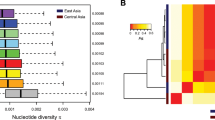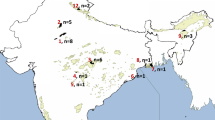Abstract
The wild Bactrian camel is one of the world’s rarest and most endangered animals and is facing hybridization threat due to human encroachment. Although captive breeding programs of the wild camel have been undertaken to save it from extinction, to succeed, we need to take into account many factors, e.g., maintain genetic diversity of captive populations similar to that found in wild populations. We applied restriction-site associated DNA sequencing (RAD-Seq) on a captive population in the most important wild camel conservation center in China—Gansu endangered animal conservation center—to investigate the genetic diversity, potential hybridization and inbreeding threats, and thus further guide population management. We sequenced a total of 44 Bactrian camels including 13 wild camels and 31 domestic camels and generated a genome-wide polymorphism dataset with 679,195 high-quality SNPs. This enabled us to detect wild camel individuals with recent genetic introgression from domestic camels. In addition, it revealed that the studied captive population suffers from inbreeding. We therefore suggest practical measures to improve the management of the wild camel and to protect its natural gene pool.



Similar content being viewed by others
References
Alexander DH, Novembre J, Lange K (2009) Fast model-based estimation of ancestry in unrelated individuals. Genome Res 19(9):1655–1664
Allendorf FW, Hohenlohe PA, Luikart G (2010) Genomics and the future of conservation genetics. Nat Rev Genet 11:697–709
Altschul SF, Gish W, Miller W, Myers EW, Lipman DJ (1990) Basic local alignment search tool. J Mol Biol 215:403–410
Anderson TM, Candille SI, Musiani M, Greco C, Stahler DR, Smith DW, Padhukasahasram B, Randi E, Leonard JA, Bustamante CD (2009) Molecular and evolutionary history of melanism in North American gray wolves. Science 323:1339–1343
Anderson CA, Pettersson FH, Clarke GM, Cardon LR, Morris AP, Zondervan KT (2010) Data quality control in genetic case-control association studies. Nat Protoc 5:1564–1573
Bannikov A (1976) Wild camels of the Gobi Wildlife, 398–403
Bowman J, Beauclerc K, Farid AH, Fenton H, Klütsch CF, Schulte-Hostedde AI (2017) Hybridization of domestic mink with wild American mink (Neovison vison) in eastern Canada. Can J Zool 95:443–451
Canavez FC, Luche DD, Stothard P, Leite KR, Sousa-Canavez JM, Plastow G, Meidanis J, Souza MA, Feijao P, Moore SS (2012) Genome sequence and assembly of Bos indicus. J Hered 103:342–348
Catchen JM, Amores A, Hohenlohe P, Cresko W, Postlethwait JH (2011) Stacks: building and genotyping loci de novo from short-read sequences. G3 1:171–182
Ceballos FC, Joshi PK, Clark DW, Ramsay M, Wilson JF (2018) Runs of homozygosity: windows into population history and trait architecture. Nat Rev Genet 19:220
Chuluunbat B, Charruau P, Silbermayr K, Khorloojav T, Burger P (2014) Genetic diversity and population structure of Mongolian domestic Bactrian camels (Camelus bactrianus). Anim Genet 45:550–558
Danecek P, Auton A, Abecasis G, Albers CA, Banks E, DePristo MA, Handsaker RE, Lunter G, Marth GT, Sherry ST (2011) The variant call format and VCF tools. Bioinformatics 27:2156–2158
Earl DA (2012) Structure Harvester: a website and program for visualizing STRUCTURE output and implementing the Evanno method. Conserv Genet Resour 4:359–361
Eaton DA (2014) PyRAD: assembly of de novo RADseq loci for phylogenetic analyses. Bioinformatics 30:1844–1849
Etter PD, Preston JL, Bassham S, Cresko WA, Johnson EA (2011) Local de novo assembly of RAD paired-end contigs using short sequencing reads. PloS ONE 6, e18561
Frankham R (2005) Genetics and extinction. Biol Conserv, 126, 131–140
Frankham R, Briscoe DA, Ballou JD (2002) Introduction to conservation genetics. Cambridge university press, Cambridge
Goldberg TL, Grant EC, Inendino KR, Kassler TW, Claussen JE, Philipp DP (2005) Increased infectious disease susceptibility resulting from outbreeding depression. Conserv Biol 19:455–462
Haig SM, Ballou JD, Derrickson SR (1990) Management options for preserving genetic diversity: reintroduction of Guam rails to the wild. Conserv Biol 4:290–300
Halbert ND, Derr JN (2006) A comprehensive evaluation of cattle introgression into US federal bison herds. J Hered 98:1–12
Hansson B, Westerberg L (2002) On the correlation between heterozygosity and fitness in natural populations. Mol Ecol 11:2467–2474
Hare J (1997) The wild bactrian camel Camelus bactrianus ferus in China: the need for urgent action. Oryx 31:45–48
Hare J (2008) Camelus ferus. The IUCN Red List of Threatened Species 2008: e.T63543A12689285. http://www.iucnredlist.org. Accessed 30 June 2017
He W, Zhao S, Liu X, Dong S, Lv J, Liu D, Wang J, Meng Z (2013) ReSeqTools: an integrated toolkit for large-scale next-generation sequencing based resequencing analysis. Genet Mol Res 12:6275–6283
Herrera S, Reyes-Herrera PH, Shank TM (2015) Predicting RAD-seq marker numbers across the eukaryotic tree of life. Genome Biol Evol 7:3207–3225
Hohenlohe PA, Amish SJ, Catchen JM, Allendorf FW, Luikart G (2011) Next-generation RAD sequencing identifies thousands of SNPs for assessing hybridization between rainbow and westslope cutthroat trout. Mol Ecol Resour 11:117–122
Ji R, Cui P, Ding F, Geng J, Gao H, Zhang H, Yu J, Hu S, Meng H (2009) Monophyletic origin of domestic bactrian camel (Camelus bactrianus) and its evolutionary relationship with the extant wild camel (Camelus bactrianus ferus). Anim Genet 40:377–382
Jirimutu, Wang Z, Ding G, Chen G, Sun Y, Sun Z, Zhang H, Wang L, Hasi S, Zhang Y, Li J, Shi Y, Xu Z, He C, Yu S, Li S, Zhang W, Batmunkh M, Ts B, Narenbatu, Unierhu, Bat-Ireedui S, Gao H, Baysgalan B, Li Q, Jia Z, Turigenbayila, Subudenggerile, Narenmanduhu, Wang Z, Wang J, Pan L, Chen Y, Ganerdene Y, Dabxilt, Erdemt, Altansha, Altansukh, Liu T, Cao M, Aruuntsever, Bayart, Hosblig, He F, Zha-ti A, Zheng G, Qiu F, Sun Z, Zhao L, Zhao W, Liu B, Li C, Chen Y, Tang X, Guo C, Liu W, Ming L, Temuulen, Cui A, Li Y, Gao J, Li J, Wurentaodi, Niu S, Sun T, Zhai Z, Zhang M, Chen C, Baldan T, Bayaer T, Li Y, Meng H (2012). Genome sequences of wild and domestic bactrian camels. Nat Commun 3:1202
Kimura M, Ohta T (1969) The average number of generations until fixation of a mutant gene in a finite population. Genetics 61:763
Korneliussen TS, Albrechtsen A, Nielsen R (2014) ANGSD: analysis of next generation sequencing data. BMC Bioinform 15:356
Kubota H, Watanabe K (2003) Genetic diversity in wild and reared populations of the Japanese bitterling Tanakia tanago (Cyprinidae). Ichthyol Res 50:123–128
Kukekova AV, Johnson JL, Xiang X, Feng S, Liu S, Rando HM, Kharlamova AV, Herbeck Y, Serdyukova NA, Xiong Z (2018) Red fox genome assembly identifies genomic regions associated with tame and aggressive behaviours. Nat Ecol Evol 2(9):1479
Lande R (1988) Genetics and demography in biological conservation. Science 241:1455–1460
Letunic I, Bork P (2006) Interactive tree of life (iTOL): an online tool for phylogenetic tree display and annotation. Bioinformatics 23:127–128
Li H, Durbin R (2009) Fast and accurate short read alignment with Burrows–Wheeler transform. Bioinformatics, 25:1754–1760
Li H, Handsaker B, Wysoker A, Fennell T, Ruan J, Homer N, Marth G, Abecasis G, Durbin R (2009) The sequence alignment/map format and SAMtools. Bioinformatics 25:2078–2079
Liu S, Lorenzen ED, Fumagalli M, Li B, Harris K, Xiong Z, Zhou L, Korneliussen TS, Somel M, Babbitt C (2014) Population genomics reveal recent speciation and rapid evolutionary adaptation in polar bears. Cell 157:785–794
Manichaikul A, Mychaleckyj JC, Rich SS, Daly K, Sale M, Chen W-M (2010) Robust relationship inference in genome-wide association studies. Bioinformatics 26:2867–2873
McKenna A, Hanna M, Banks E, Sivachenko A, Cibulskis K, Kernytsky A, Garimella K, Altshuler D, Gabriel S, Daly M (2010) The genome analysis toolkit: a MapReduce framework for analyzing next-generation DNA sequencing data. Genome Res 20(9):1297–1303
Milot E, Perrier C, Papillon L, Dodson JJ, Bernatchez L (2013) Reduced fitness of Atlantic salmon released in the wild after one generation of captive breeding. Evol Appl 6:472–485
Mohandesan E, Fitak RR, Corander J, Yadamsuren A, Chuluunbat B, Abdelhadi O, Raziq A, Nagy P, Stalder G, Walzer C (2017) Mitogenome sequencing in the genus Camelus reveals evidence for purifying selection and long-term divergence between wild and domestic bactrian camels. Sci Rep 7:9970
Narasimhan V, Danecek P, Scally A, Xue Y, Tyler-Smith C, Durbin R (2016) BCFtools/RoH: a hidden Markov model approach for detecting autozygosity from next-generation sequencing data. Bioinformatics 32:1749–1751
Narum SR, Buerkle CA, Davey JW, Miller MR, Hohenlohe PA (2013) Genotyping-by-sequencing in ecological and conservation genomics. Mol Ecol 22:2841–2847
Ostrowski S, Lenain DM, Bedin E, Abuzinada AH(1998) Ten years of Arabian oryx conservation breeding in Saudi Arabia - achievements and regional perspectives. Oryx 32(3):209–222
Peer K, Taborsky M (2005) Outbreeding depression, but no inbreeding depression in haplodiploid ambrosia beetles with regular sibling mating. Evolution 59:317–323
Peripolli E, Munari D, Silva M, Lima A, Irgang R, Baldi F (2017) Runs of homozygosity: current knowledge and applications in livestock. Anim Genet 48:255–271
Purcell S, Neale B, Todd-Brown K, Thomas L, Ferreira MA, Bender D, Maller J, Sklar P, De Bakker PI, Daly MJ (2007) PLINK: a tool set for whole-genome association and population-based linkage analyses. Am J Hum Genet 81:559–575
Randi E (2008) Detecting hybridization between wild species and their domesticated relatives. Mol Ecol 17:285–293
Reed DH, Frankham R (2003) Correlation between fitness and genetic diversity. Conserv Biol 17:230–237
Rogers J, Gibbs RA (2014) Comparative primate genomics: emerging patterns of genome content and dynamics. Nat Rev Genet 15:347
Saitou N, Nei M (1987) The neighbor-joining method: a new method for reconstructing phylogenetic trees. Mol Biol Evol 4:406–425
Schwartz MK, Luikart G, Waples RS (2007) Genetic monitoring as a promising tool for conservation and management. Trends Ecol Evol 22:25–33
Shirley M, Villanova V, Vliet K, Austin J (2015) Genetic barcoding facilitates captive and wild management of three cryptic African crocodile species complexes. Anim Conserv 18:322–330
Silbermayr K, Orozco-terWengel P, Charruau P, Enkhbileg D, Walzer C, Vogl C, Schwarzenberger F, Kaczensky P, Burger P (2010) High mitochondrial differentiation levels between wild and domestic Bactrian camels: a basis for rapid detection of maternal hybridization. Anim Genet 41:315–318
Wei F, Swaisgood R, Hu Y, Nie Y, Yan L, Zhang Z, Qi D, Zhu L (2015) Progress in the ecology and conservation of giant pandas. Conserv Biol 29:1497–1507
Whiteley AR, Fitzpatrick SW, Funk WC, Tallmon DA (2015) Genetic rescue to the rescue. Trends Ecol Evol 30:42–49
Willoughby JR, Fernandez NB, Lamb MC, Ivy JA, Lacy RC, DeWoody JA (2015) The impacts of inbreeding, drift and selection on genetic diversity in captive breeding populations. Mol Ecol 24:98–110
Wu H, Guang X, Al-Fageeh MB, Cao J, Pan S, Zhou H, Zhang L, Abutarboush MH, Xing Y, Xie Z (2014) Camelid genomes reveal evolution and adaptation to desert environments. Nat Commun 5:5188
Yadamsuren A, Dulamtseren E, Reading RP (2012) The conservation status and management of wild camels in Mongolia. na
Zeng Y, Jiang Z, Li C (2006) Genetic variability in relocated Père David’s deer (Elaphurus davidianus) populations—Implications to reintroduction program. Conserv Genet 8:1051–1059
Acknowledgements
This work was supported by the Public Welfare Project of the National Scientific Research Institution (CAFYBB2011003), National Biological Specimens and Resources Sharing Platform in Nature Reserve (2005DKA21404), Free-oriented Project from Shenzhen Government (JCYJ20170817150755701). We are grateful to the Endangered Animal Conservation Center and Xihu National Nature Reserve in Gansu province for providing the valuable samples. We thank Rasmus Heller and Shyam Gopalakrishnan at Copenhagen University for analysis advice.
Author information
Authors and Affiliations
Corresponding authors
Additional information
Publisher’s Note
Springer Nature remains neutral with regard to jurisdictional claims in published maps and institutional affiliations.
Electronic supplementary material
Below is the link to the electronic supplementary material.
Rights and permissions
About this article
Cite this article
Zhang, Y., Zhong, Y., Hong, Y. et al. RAD-Seq data advance captive-based conservation of wild bactrian camels (Camelus ferus). Conserv Genet 20, 817–824 (2019). https://doi.org/10.1007/s10592-019-01173-5
Received:
Accepted:
Published:
Issue Date:
DOI: https://doi.org/10.1007/s10592-019-01173-5




